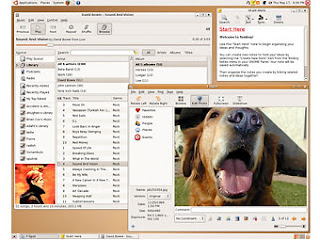VMware Inc today released version 6 of its industry-leading virtualization product VMware Workstation. VMware Workstation runs under a wide range of Linux and Windows versions and allows installation of an even wider range of guest operating systems within virtual machines. Among many possible applications are letting help desk personnel easily keep different Windows versions at hand, testing new software products under a variety of environments, and analyzing malicious software without the risk that it might damage a physical computer. Version 6 adds full support for Windows Vista both as host and guest along with significant feature enhancements from the previous version.
With this version, VMware's support for Windows Vista moves from "experimental" to mainstream. It fully supports all aspects of Vista inside a virtual machine except for the high-end graphics. At this time it doesn't provide the 3D graphics support necessary for Vista's Aero Glass display mode. However, VMware's senior director of virtual software lifecycle automation James Phillips said that this will change, as the necessary support is "in the lab" at present.
This version's support for multiple monitors is both powerful and flexible. The user can configure a single virtual machine to span multiple monitors or assign each monitor to a separate virtual machine. Long-time users will be pleased with the new virtual USB 2.0 ports--no more annoying "This device can perform faster" messages. The product currently has the ability to "clone" a virtual machine, producing either an independent duplicate or a space-saving duplicate that stores only what differs from the original. New in version 6 is the ability to clone a physical computer, quickly replicating the system as a virtual machine.
In addition, it adds remote-access capability based on VNC (Virtual Network Computing). The user must actively enable this feature--it's off by default for security--and allows authorized users with proper credentials to operate a virtual machine remotely without installing any additional software within the VM. As Phillips pointed out, VMware is already completely in control of the virtual machine's input and output, so going remote is just a short step.
VMware Workstation 6 makes new strides in integration as well. Software developers using Microsoft's Virtual Studio or the open-source Eclipse development platform now can compile a new build and run it in an automatically-created virtual machine, thereby avoiding the risk that a program flaw could damage the system being used for development. And the programmer has full control via the integrated virtual debugger. The new version also supports paravirtualization using the industry standard Virtual Machine Interface 3.0. The guest operating system can get better performance by taking advantage of VMI. Ubuntu Linux is the first to offer this support; Phillips said that many others have expressed support and will be implementing it.
On the bleeding edge, this new version adds experimental support for full record/replay within a virtual machine. That means it can record every single event that affects the virtual CPU's operation and play back those same events to exactly duplicate, for example, an intermittent software problem. Phillips explained that this feature is entirely independent of which guest operating system is used. VMware Workstation 6 is available as an electronic download directly from VMware for $189.
Resources: PC Magazine, VMware
Read more!

















